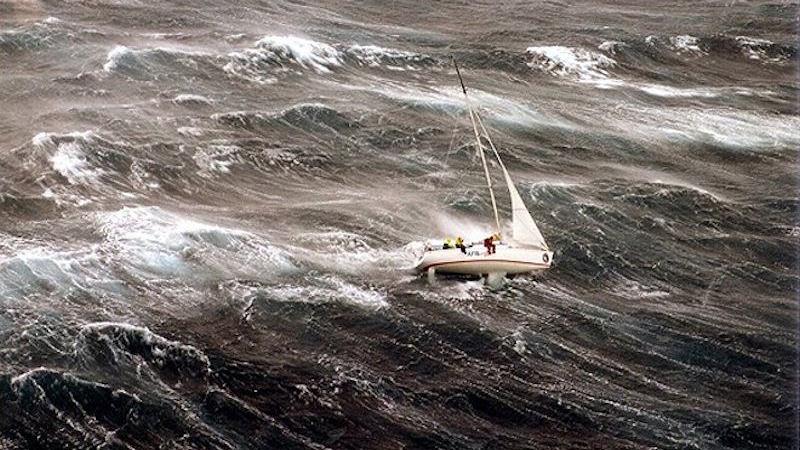

Twin rudders aren’t universally popular because, although they will usually keep a boat under control at higher angles of heel, they tend to give less feedback through the wheel.
Another consideration is the lack of prop-wash, making marina manoeuvres more of a challenge.
Given that most boats of this size will have a bow-thruster, that might not be an issue for everyone. The pros and cons of twin rudders are widely debated and they extend well beyond the aspects touched on here.
Ultimately it comes down to what you prefer in terms of feel and handling, though it’s also good to be aware of the wider implications, including how they relate to hull shape and the inherent nature of the boat.
Good use of space on the Elan Impression 43
Now we’ve covered some of the basics, what is the Elan Impression 43 actually like on board?
Let’s start in the stern, and with features that are rarely worthy of any particular comment: the steering pedestals.
Here they are worthy of comment because, instead of being bolted to the cockpit sole in the conventional manner, they grow out of the sides of the cockpit in a stylish design that stems from Elan’s collaboration with Pininfarina.
Importantly, the helm positions are not as far aft as on some boats, so you don’t feel as though you’re being pushed off the stern.
Forward of the wheels, the coamings slope upwards to meet the top of the semi-raised coachroof, so they’re much higher than on most boats, creating a cockpit that’s unusually secure and well-sheltered.
Inboard of the L-shaped seats on each side are drop-leaf tables on tubular stainless steel frames.A self-tacking jib comes as standard on the Elan Impression 43. The overlapping headsail sheets to tracks on the inboard side of the decks
You can lower the outboard leaves to create large lounging areas with infill cushions.
If both inboard leaves are raised, they meet on the centreline to create an enormous full-width table.
Importantly, the tables are also reassuringly sturdy, so you can stand on them with confidence while stowing the mainsail.
On the day of our test, we left hoisting the mainsail until we had motored far enough downwind to give ourselves a beat back towards Portland Harbour.
Going downwind under plain sail in light airs rarely teaches you anything about a boat whereas, in this instance, motoring did.
Most noticeably, it showed that the water still flowed cleanly off the stern at 6.5 knots. That’s unusual.
Cruising yachts typically start dragging their sterns and creating turbulence as soon as they’re moving at more than 3 or 4 knots, largely because they rarely have more than a few inches of clearance between the static waterline and the lip of the transom.
That in turn is a function of the design, the total weight (often well in excess of the designed weight) and the fore-and-aft weight distribution.
The Elan’s longitudinal centre of buoyancy is well aft, but she has sufficient rocker back there for the stern to remain well clear.
Our test boat was in an unladen state because she had been commissioned only a few days earlier and this was her first outing.
Then again, most new boats I test are unladen or only lightly laden and they still drag their sterns.
As is common on newly commissioned boats with twin rudders, there was a little stiffness in the steering that, I expect, would ease after a
The largest engine is 80hp; rather more than necessary, I would suggest, and at a premium of nearly £10,000.
By the time we spun into the wind, set sail and turned off the engine, the breeze had kicked in and we saw about 15 knots across the deck.
The boat got straight into gear, clocking an easy 6 knots with the apparent wind at around 35°.
Over the course of the following few hours, a further increase in wind saw the anemometer registering 20 knots as we trucked upwind at a healthy 7 knots with a light helm, the AWA (apparent wind angle) at a little over 30° and the boat feeling very nicely balanced.
Twin rudders aren’t universally popular because, although they will usually keep a boat under control at higher angles of heel, they tend to give less feedback through the wheel.
Another consideration is the lack of prop-wash, making marina manoeuvres more of a challenge.
Given that most boats of this size will have a bow-thruster, that might not be an issue for everyone. The pros and cons of twin rudders are widely debated and they extend well beyond the aspects touched on here.
Ultimately it comes down to what you prefer in terms of feel and handling, though it’s also good to be aware of the wider implications, including how they relate to hull shape and the inherent Now we’ve covered some of the basics, what is the Elan Impression 43 actually like on board?
Let’s start in the stern, and with features that are rarely worthy of any particular comment: the steering pedestals.
Here they are worthy of comment because, instead of being bolted to the cockpit sole in the conventional manner, they grow out of the sides of the cockpit in a stylish design that stems from Elan’s collaboration with Pininfarina.
Importantly, the helm positions are not as far aft as on some boats, so you don’t feel as though you’re being pushed off the stern.
Forward of the wheels, the coamings slope upwards to meet the top of the semi-raised coachroof, so they’re much higher than on most boats, creating a cockpit that’s unusually secure and well-sheltered.
Inboard of the L-shaped seats on each side are drop-leaf tables on tubular stainless steel frames.A self-tacking jib comes as standard on the Elan Impression 43. The overlapping headsail sheets to tracks on the inboard side of the decks
You can lower the outboard leaves to create large lounging areas with infill cushions.
If both inboard leaves are raised, they meet on the centreline to create an enormous full-width table.
Importantly, the tables are also reassuringly sturdy, so you can stand on them with confidence while stowing the mainsail.
On the day of our test, we left hoisting the mainsail until we had motored far enough downwind to give ourselves a beat back towards Portland Harbour.
Going downwind under plain sail in light airs rarely teaches you anything about a boat whereas, in this instance, motoring did.
Most noticeably, it showed that the water still
Pedestals for the twin wheels appear to grow out of the cockpit sides, and incorporate consoles with space for instrumentation
Cruising yachts typically start dragging their sterns and creating turbulence as soon as they’re moving at more than 3 or 4 knots, largely because they rarely have more than a few inches of clearance between the static waterline and the lip of the transom.
That in turn is a function of the design, the total weight (often well in excess of the designed weight) and the fore-and-aft weight distribution.
The Elan’s longitudinal centre of buoyancy is well aft, but she has sufficient rocker back there for the stern to remain well clear.
Our test boat was in an unladen state because she had been commissioned only a few days earlier and this was her first outing.
Then again, most new boats I test are unladen or only lightly laden and they still drag their sterns.
As is common on newly commissioned boats with twin rudders, there was a little stiffness in the steering that, I expect, would ease after a few miles.
Powering up
Engine-wise, the I43 comes as standard with a 45hp Yanmar. We had the next option up, the 57hp, which drove a Flexofold prop and gave us 6.4 knots at a very easy 1,800rpm.
The largest engine is 80hp; rather more than necessary, I would suggest, and at a premium of nearly £10,000.
By the time we spun into the wind, set sail and turned off the engine, the breeze had kicked in and we saw about 15 knots across the deck.
The boat got straight into gear, clocking an easy 6 knots with the apparent wind at around 35°.
Over the course of the following few hours, a further increase in wind saw the anemometer registering 20 knots as we trucked upwind at a healthy 7 knots with a light helm, the AWA (apparent wind angle) at a little over 30° and the boat feeling very nicely balanced.
Leave a Reply